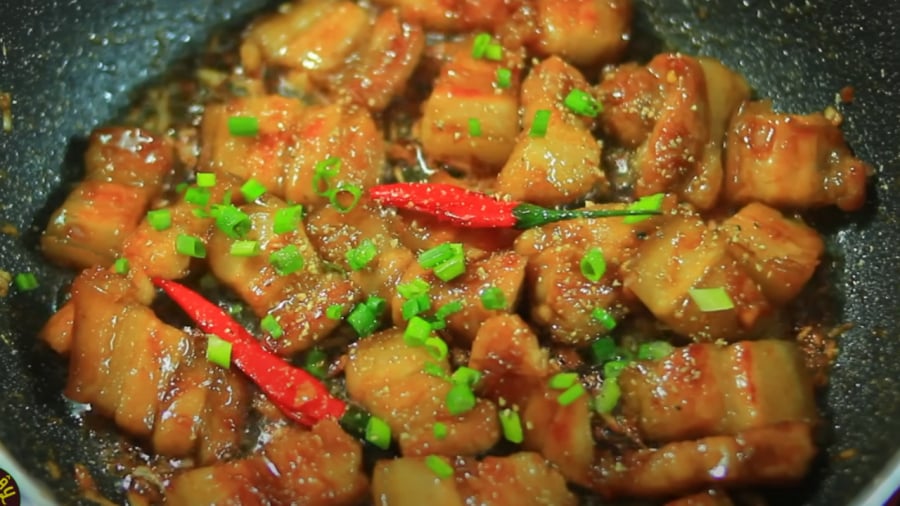Why add shallots to stir-fried burnt-edge pork?
**- Related to traditional taste**
Shallots are an indispensable spice in many Vietnamese dishes. In the past, the elders also summed up the experience of using spices for dishes in the nursery rhyme: “The clucking chicken with lime leaves / The oinking pig, buy shallots for me / The dog cries standing, sitting and crying / Ma, go to the market and buy me some ginger”. Accordingly, when processing dishes from pork, shallots (including dried shallots, shallot bulbs, and scallions) are suitable spices. Northern-style stir-fried and stewed pork dishes will include dried and green onions to enhance the flavor of the dish.
**- Pork combined with shallots is a precious medicine**
According to Oriental medicine, shallots have a spicy taste, a warm nature, antiseptic, cold-relieving, qi-relieving, and calming effects on the five organs. Meanwhile, pork has a sweet and salty taste, a cold or neutral nature, entering the spleen, stomach, and kidneys, helping to nourish the body, relieve colds, treat malaria, promote blood flow, and benefit the five organs…
The combination of pork and shallots brings a harmonious yin and yang effect, nourishing the body, relieving colds, treating malaria, promoting blood flow, and benefiting the five organs.

Stir-fried burnt-edge pork cannot be missing dried and green onions.
**- From a culinary perspective**
From a culinary perspective, shallots contain malic acid, phytic acid, and allyl sulfite. The essential oil in shallots contains the antibiotic alixin C6H10OS₂, which has antibacterial and deodorizing effects on pork.
Particularly, dry shallot bulbs contain a high amount of sulfur compounds that promote the Maillard reaction between sugar molecules and amino groups in protein molecules of meat, making the meat more flavorful and visually appealing.
**Some notes when making stir-fried burnt-edge pork**
When making stir-fried burnt-edge pork, choose pork belly with both lean and fatty parts, in contiguous chunks. Rinse the meat with clean water. Depending on your preference, you can keep or remove the skin. Cut the meat into bite-sized pieces, but not too thin, as the meat will shrink during stir-frying.
In addition to pork, you will need other ingredients such as sliced dried shallots, chopped scallions, fish sauce, and sugar. You can also add a little bit of caramel sauce to give the dish a nicer color.
Stir-fry the meat continuously over high heat until the surface is slightly charred, or use a grill pan to char the meat before flipping it over. Adjust the heat and monitor the meat so that it is golden brown on the outside. This way, the meat will remain tender and moist, not dry and tough.
Reduce the heat and add the fish sauce and sugar, stirring quickly to coat the meat with the seasonings. Add the sliced dried shallots and stir to combine. Increase the heat slightly to enhance the flavor and color of the dish. You can also add chili peppers to taste.
Finally, add the scallions and pepper, and your dish is ready to be served!
The Ancient Wisdom: Unraveling the Mystery of the ‘House of Yang’ and the ‘House of Yin’
“The home is a pivotal aspect of one’s destiny, as the ancient proverb goes, ‘A Yang house next to a Yin house will bring three generations of decline, if not ruin.’ This proverb underscores the belief that the placement and energy of one’s home can significantly impact their fortune and legacy. It is a reminder that the choices we make about our living spaces can have profound consequences on our future.”
The Altar’s Fruitful Warning: A Single Banana Bunch is Prosperity, a Pair Brings Calamity.
The practice of combining two banana stalks to create a larger offering is a common but ill-advised shortcut. According to Feng Shui principles, this makeshift arrangement can lead to financial setbacks and misfortune. It is believed that the imbalance created by the combined stalks disrupts the harmonious energy flow, resulting in negative consequences. A single, ample banana stalk is always the preferred choice for a prosperous and auspicious offering.






































